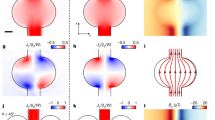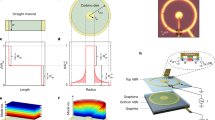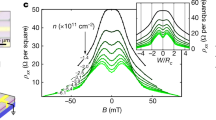Abstract
In the presence of interactions, electrons in condensed-matter systems can behave hydrodynamically, exhibiting phenomena associated with classical fluids, such as vortices and Poiseuille flow1,2,3. In most conductors, electron–electron interactions are minimized by screening effects, hindering the search for hydrodynamic materials; however, recently, a class of semimetals has been reported to exhibit prominent interactions4,5. Here we study the current flow in the layered semimetal tungsten ditelluride by imaging the local magnetic field using a nitrogen-vacancy defect in a diamond. We image the spatial current profile within three-dimensional tungsten ditelluride and find that it exhibits non-uniform current density, indicating hydrodynamic flow. Our temperature-resolved current profile measurements reveal a non-monotonic temperature dependence, with the strongest hydrodynamic effects at approximately 20 K. We also report ab initio calculations showing that electron–electron interactions are not explained by the Coulomb interaction alone, but are predominantly mediated by phonons. This provides a promising avenue in the search for hydrodynamic flow and prominent electron interactions in high-carrier-density materials.
This is a preview of subscription content, access via your institution
Access options
Access Nature and 54 other Nature Portfolio journals
Get Nature+, our best-value online-access subscription
$29.99 / 30 days
cancel any time
Subscribe to this journal
Receive 12 print issues and online access
$209.00 per year
only $17.42 per issue
Buy this article
- Purchase on Springer Link
- Instant access to full article PDF
Prices may be subject to local taxes which are calculated during checkout




Similar content being viewed by others
Data availability
Data for figures that support the manuscript are available at https://doi.org/10.7910/DVN/ULRIZG. All other data that support the findings of this paper are available from the corresponding authors upon request.
Code availability
Source codes for the ab initio model and Boltzmann transport equation calculation are available from the corresponding authors upon request.
References
Gurzhi, R. N. Hydrodynamic effects in solids at low temperature. Sov. Phys. Usp. 11, 255–270 (1968).
Levitov, L. & Falkovich, G. Electron viscosity, current vortices and negative nonlocal resistance in graphene. Nat. Phys. 12, 672–676 (2016).
Andrew, L. & Fong, K. C. Hydrodynamics of electrons in graphene. J. Phys. Condens. Matter 30, 053001 (2018).
Moll, P. J. W., Kushwaha, P., Nandi, N., Schmidt, B. & Mackenzie, A. P. Evidence for hydrodynamic electron flow in PdCoO2. Science 351, 1061–1064 (2016).
Gooth, J. et al. Thermal and electrical signatures of a hydrodynamic electron fluid in tungsten diphosphide. Nat. Commun. 9, 4093 (2018).
de Jong, M. J. M. & Molenkamp, L. W. Hydrodynamic electron flow in high-mobility wires. Phys. Rev. B 51, 13389–13402 (1995).
Bandurin, D. A. et al. Negative local resistance caused by viscous electron backflow in graphene. Science 351, 1055–1058 (2016).
Jesse, C. et al. Observation of the Dirac fluid and the breakdown of the Wiedemann–Franz law in graphene. Science 351, 1058–1061 (2016).
Krishna Kumar, R. et al. Superballistic flow of viscous electron fluid through graphene constrictions. Nat. Phys. 13, 1182–1185 (2017).
Sulpizio, J. A. et al. Visualizing Poiseuille flow of hydrodynamic electrons. Nature 576, 75–79 (2019).
Ku, M. J. H. et al. Imaging viscous flow of the Dirac fluid in graphene. Nature 583, 537–541 (2020).
Jenkins, A. et al. Imaging the breakdown of ohmic transport in graphene. Preprint at https://arxiv.org/abs/2002.05065 (2020).
Ali, M. N. et al. Large, non-saturating magnetoresistance in WTe2. Nature 514, 205–208 (2014).
Kang, D. et al. Superconductivity emerging from a suppressed large magnetoresistant state in tungsten ditelluride. Nat. Commun. 6, 7804 (2015).
Pan, X.-C. et al. Pressure-driven dome-shaped superconductivity and electronic structural evolution in tungsten ditelluride. Nat. Commun. 6, 7805 (2015).
Soluyanov, A. A. et al. Type-II Weyl semimetals. Nature 527, 495–498 (2015).
Peng, L. et al. Evidence for topological type-II Weyl semimetal WTe2. Nat. Commun. 8, 2150 (2017).
Lin, C.-L. et al. Visualizing type-II Weyl points in tungsten ditelluride by quasiparticle interference. ACS Nano 11, 11459–11465 (2017).
Lv, Y.-Y. et al. Experimental observation of anisotropic Adler–Bell–Jackiw anomaly in type-II Weyl semimetal WTe1.98 crystals at the quasiclassical regime. Phys. Rev. Lett. 118, 096603 (2017).
Sie, E. J. et al. An ultrafast symmetry switch in a Weyl semimetal. Nature 565, 61–66 (2019).
Sanfeng, W. et al. Observation of the quantum spin Hall effect up to 100 kelvin in a monolayer crystal. Science 359, 76–79 (2018).
Valla, F. et al. Electrically tunable low-density superconductivity in a monolayer topological insulator. Science 362, 926–929 (2018).
Sajadi, E. et al. Gate-induced superconductivity in a monolayer topological insulator. Science 362, 922–925 (2018).
Zhu, Z. et al. Quantum oscillations, thermoelectric coefficients, and the Fermi surface of semimetallic WTe2. Phys. Rev. Lett. 114, 176601 (2015).
Coulter, J., Sundararaman, R. & Narang, P. Microscopic origins of hydrodynamic transport in the type-II Weyl semimetal WP2. Phys. Rev. B 98, 115130 (2018).
Levchenko, A. & Schmalian, J. Transport properties of strongly coupled electron–phonon liquids. Ann. Phys. 419, 168218 (2020).
Maletinsky, P. et al. A robust scanning diamond sensor for nanoscale imaging with single nitrogen-vacancy centres. Nat. Nanotechnol. 7, 320–324 (2012).
Pelliccione, M. et al. Scanned probe imaging of nanoscale magnetism at cryogenic temperatures with a single-spin quantum sensor. Nat. Nanotechnol. 11, 700–705 (2016).
Zhou, T. X., Stöhr, R. J. & Yacoby, A. Scanning diamond NV center probes compatible with conventional AFM technology. Appl. Phys. Lett. 111, 163106 (2017).
Ling, X., Zhou, T. X., Stöhr, R. J. & Yacoby, A. Crystallographic orientation dependent reactive ion etching in single crystal diamond. Adv. Mater. 30, 1705501 (2018).
Casola, F., van der Sar, T. & Yacoby, A. Probing condensed matter physics with magnetometry based on nitrogen-vacancy centres in diamond. Nat. Rev. Mater. 3, 17088 (2018).
Guyer, R. A. & Krumhansl, J. A. Thermal conductivity, second sound, and phonon hydrodynamic phenomena in nonmetallic crystals. Phys. Rev. 148, 778–788 (1966).
Hartnoll, S. A., Kovtun, P. K., Müller, M. & Sachdev, S. Theory of the Nernst effect near quantum phase transitions in condensed matter and in dyonic black holes. Phys. Rev. B 76, 144502 (2007).
Davison, R. A., Schalm, K. & Zaanen, J. Holographic duality and the resistivity of strange metals. Phys. Rev. B 89, 245116 (2014).
Georgios, V., Jermyn, A. S., Polina, A., Claudia, F. & Prineha, N. Electron hydrodynamics in anisotropic materials. Nat. Commun. 11, 4710 (2020).
Brown, A. M., Sundararaman, R., Narang, P., Goddard, W. A. & Atwater, H. A. Nonradiative plasmon decay and hot carrier dynamics: effects of phonons, surfaces, and geometry. ACS Nano 10, 957–966 (2015).
Prineha, N., Ravishankar, S., Jermyn, A. S., Goddard, W. A. & Atwater, H. A. Cubic nonlinearity driven up-conversion in high-field plasmonic hot carrier systems. J. Phys. Chem. C 120, 21056–21062 (2016).
Garcia, C. A. C., Coulter, J. & Narang, P. Optoelectronic response of the type-I Weyl semimetals TaAs and NbAs from first principles. Phys. Rev. Res. 2, 013073 (2020).
Ciccarino, C. J., Christensen, T., Sundararaman, R. & Narang, P. Dynamics and spin-valley locking effects in monolayer transition metal dichalcogenides. Nano Lett. 18, 5709–5715 (2018).
Nam, Y., Ki, D.-K., Soler-Delgado, D. & Morpurgo, A. F. Electron–hole collision limited transport in charge-neutral bilayer graphene. Nat. Phys. 13, 1207–1214 (2017).
Rahbar, S. & Hashemizadeh, E. A computational approach to the Fredholm integral equation of the second kind. In Proc. World Congress on Engineering Vol. 2 (eds Ao, S. I. et al.) 933–937 (Newswood, 2008).
Ali, M. N. et al. Correlation of crystal quality and extreme magnetoresistance of WTe2. Europhys. Lett. 110, 67002 (2015).
Luo, Y. et al. Hall effect in the extremely large magnetoresistance semimetal WTe2. Appl. Phys. Lett. 107, 182411 (2015).
Zhao, Y. et al. Anisotropic magnetotransport and exotic longitudinal linear magnetoresistance in WTe2 crystals. Phys. Rev. B 92, 041104 (2015).
Acknowledgements
We thank M. Ku and A. S. Jermyn for fruitful discussions. We also thank P. Gumann and R. Stöhr for the initial design and construction of the microscope. T.X.Z. thanks R. Walsworth and M. Turner for diamond-processing assistance. Funding: this work was primarily supported by ARO grant no. W911NF-17-1-0023 and the Gordon and Betty Moore Foundations EPiQS Initiative through grant no. GBMF4531. Fabrication of samples was supported by the US Department of Energy (DOE), Basic Energy Sciences Office, Division of Materials Sciences and Engineering, under award DE-SC0019300. A.Y. acknowledges support from ARO grants W911NF-18-1-0316 and W911NF-1-81-0206, NSF grant DMR-1708688, and the STC Center for Integrated Quantum Materials, NSF grant no. DMR-1231319, and the Aspen Center of Physics supported by NSF grant PHY-1607611. G.V., Y.W. and P.N. acknowledge support from the Army Research Office MURI (Ab-Initio Solid-State Quantum Materials) grant no. W911NF-18-1-0431, which supported the development of computational methods to describe the microscopic, temperature-dependent dynamics in low-dimensional materials. G.V. acknowledges support from the Office of Naval Research grant on High-Tc Superconductivity at Oxide–Chalcogenide Interfaces (grant no. N00014-18-1-2691), which supported the theoretical and computational methods for phonon-mediated interactions. Y.W. is partially supported by the STC Center for Integrated Quantum Materials, NSF grant no. DMR-1231319, for the development of computational methods for topological materials. This research used resources of the National Energy Research Scientific Computing Center, a DOE Office of Science User Facility supported by the Office of Science of the US Department of Energy under contract no. DE-AC02-05CH11231 as well as resources at the Research Computing Group at Harvard University. This work was performed, in part, at the Center for Nanoscale Systems (CNS), a member of the National Nanotechnology Infrastructure Network, which is supported by the NSF under award no. ECS-0335765. CNS is part of Harvard University. P.N. is a Moore Inventor Fellow and gratefully acknowledges support through grant no. GBMF8048 from the Gordon and Betty Moore Foundation. C.A.C.G. acknowledges support from the NSF Graduate Research Fellowship Program under grant no. DGE-1745303. A.T.P. acknowledges support from the Department of Defense (DOD) through the National Defense Science and Engineering Graduate Fellowship (NDSEG) Program.
Author information
Authors and Affiliations
Contributions
J.G., P.N. and A.Y. conceived the project. U.V., A.H., T.X.Z. and Y.D. designed and developed the experimental setup under the guidance of A.Y. N.K. and J.G. grew the bulk WTe2 crystals under the guidance of C.F. U.V., A.H., Z.Q. and A.T.P fabricated and characterized the WTe2 flakes. G.V. implemented the numerical BTE methods under the guidance of P.A. and P.N. G.V., Y.W. and C.A.C.G. developed and implemented the ab initio theoretical methods under the guidance of P.N. U.V., A.H., G.V., Y.W., P.N. and A.Y. analysed the data and discussed the results. All the authors contributed to the writing of the manuscript.
Corresponding authors
Ethics declarations
Competing interests
The authors declare no competing interests.
Additional information
Peer review information Nature Physics thanks Sergey Dushenko and the other, anonymous, reviewer(s) for their contribution to the peer review of this work.
Publisher’s note Springer Nature remains neutral with regard to jurisdictional claims in published maps and institutional affiliations.
Extended data
Extended Data Fig. 1 Residual resistivity ratio and quantum oscillations.
a, Temperature dependent resistivity at zero magnetic field. The residual resistivity ratio (RRR) between 300 Kand 2 K is approximately 2000, signifying the high quality of the single crystal. b, Magnetic field (applied along the ĉ-axis) dependent resistivity showing Shubnikov-de Haas oscillations at 2 K. c, The fast Fourier transform (FFT) of the background-subtracted data of (b) when plotted against the inverse of the magnetic field. We notice four fundamental peaks corresponding to the extremal orbits of the electron and hole pockets in the Brillouin zone24.
Extended Data Fig. 2 Magnetic field dependent resistivity.
Fitting of the magnetic field dependent resistivity at 2 K according to the relation \(\frac{\rho (B)-\rho (0)}{\rho (0)}={({\mu }_{av}B)}^{2}\) where μav is the average mobility24,42. This allows us to extract μav = 2.5 × 105cm2/Vs. Using the relation σ = μne, the average carrier density n = 1.47 × 1020 cm−3 can be extracted.
Extended Data Fig. 3 Hall resistivity fitted to the two-band model.
a, b, Hall resistivity vs. magnetic field measured at different temperatures. The data is fitted according to the two band model \({\rho }_{xy}=\frac{B}{e}\frac{({n}_{h}{\mu }_{h}^{2}-{n}_{e}{\mu }_{e}^{2})+({n}_{h}-{n}_{e}){\mu }_{h}^{2}{\mu }_{e}^{2}{B}^{2}}{{({n}_{h}{\mu }_{h}+{n}_{e}{\mu }_{e})}^{2}+{({n}_{h}-{n}_{e})}^{2}{\mu }_{h}^{2}{\mu }_{e}^{2}{B}^{2}}\)43,44. c, Carrier density of electrons and holes vs. temperature, extracted from the fits in (a) and (b). d, Mobility of electrons and holes vs. temperature, extracted from the fits in (a) and (b).
Extended Data Fig. 4 WTe2 device.
Optical image of the WTe2 sample used for the majority of the data in the manuscript, including Main text Fig. 2, 3, and 4. The 100 μm long flake is contacted at its ends with gold contacts. The path along which our magnetic field profiles were taken is shown in white. An additional gold line nearby is used for delivery of RF power to manipulate the NV.
Extended Data Fig. 5 Diamond scanning probe.
a, An optical image of our scanning tip. A quartz rod is glued to the edge of one of the prongs of a quartz tuning fork. A diamond cube of 50 × 50 × 125 μm is glued to the other side of the rod. b, A closeup image of the diamond cube, with a 3 μm etched pillar visible. This pillar is used as our scanning probe, and an NV defect is located approximately 20 nm away from the pillar edge.
Extended Data Fig. 6 Multiple pillar sensing.
a, A schematic for multiple pillar sensing. The diamond is tilted at an angle θ (using goniometric motors) so that one pillar is in contact with the substrate, while the scanning pillar maintains a constant height above the sample without touching it. The angle θ controls the height of the NV probe above the sample. b, An optical image of a multiple pillar scanning tip with 7 pillars. The extreme pillars are made to be thicker so they are optimized for durability in contact, while the central pillars are optimized for NV sensing.
Supplementary information
Supplementary Information
Supplementary Sections 1–15 and Figs. 1–14.
Rights and permissions
About this article
Cite this article
Vool, U., Hamo, A., Varnavides, G. et al. Imaging phonon-mediated hydrodynamic flow in WTe2. Nat. Phys. 17, 1216–1220 (2021). https://doi.org/10.1038/s41567-021-01341-w
Received:
Accepted:
Published:
Issue Date:
DOI: https://doi.org/10.1038/s41567-021-01341-w
This article is cited by
-
Charge transport and hydrodynamics in materials
Nature Reviews Materials (2023)
-
Para-hydrodynamics from weak surface scattering in ultraclean thin flakes
Nature Communications (2023)
-
Visualization of bulk and edge photocurrent flow in anisotropic Weyl semimetals
Nature Physics (2023)
-
Perspective: nanoscale electric sensing and imaging based on quantum sensors
Quantum Frontiers (2023)
-
Preparation of metrological states in dipolar-interacting spin systems
npj Quantum Information (2022)



